Themed collection Editor’s Collection: Bio-applications of MOFs

Enzyme encapsulation in metal–organic frameworks for applications in catalysis
Various methods for encapsulating enzymes in metal–organic frameworks are discussed and the catalytic activity of biocomposites prepared using these methods is highlighted.
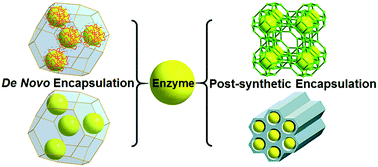
CrystEngComm, 2017,19, 4082-4091
https://doi.org/10.1039/C7CE00022G
Mechanochemical approaches towards the in situ confinement of 5-FU anti-cancer drug within MIL-100 (Fe) metal–organic framework
Low-cost mechanochemistry methods for in situ confinement of “guest” drug molecules into a “host” metal–organic framework to yield nanoscale guest@host drug delivery systems.
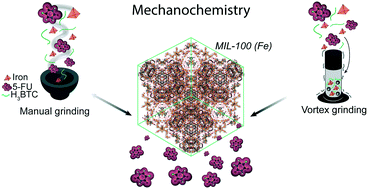
CrystEngComm, 2020,22, 4526-4530
https://doi.org/10.1039/D0CE00638F
Synthesis of spiny metal–phenolic coordination crystals as a sensing platform for sequence-specific detection of nucleic acids
Metal–phenolic coordination crystals with a spiny surface and tunable compositions are synthesized, and can be used as DNA sensors.
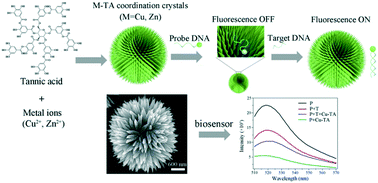
CrystEngComm, 2018,20, 7626-7630
https://doi.org/10.1039/C8CE01555D
Biocompatible MOFs with high absolute quantum yield for bioimaging in the second near infrared window
Biocompatible mixed metal YbNd metal–organic frameworks are demonstrated to be highly efficient emitters in the second NIR window.

CrystEngComm, 2018,20, 5919-5924
https://doi.org/10.1039/C8CE00909K
Fabrication of a dual-emitting RhB@Zn-1 composite as a recyclable luminescent sensor for sensitive detection of nitrofuran antibiotics
A novel dual-emitting RhB@Zn-1 composite was fabricated by encapsulating RhB into the channels of Zn-1, which can serve as a recyclable sensor for sensitive and selective detection of nitrofuran antibiotics via the luminescence quenching process.
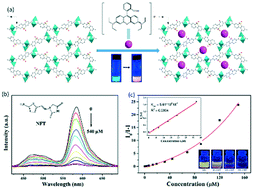
CrystEngComm, 2021,23, 629-637
https://doi.org/10.1039/D0CE01483D
Synthesis of fluorescent MOFs: live-cell imaging and sensing of a herbicide
Various metal–organic frameworks of Zn(II) and Cd(II) have been synthesized hydrothermally for the detection of herbicide (simazine) as well as nitro-aromatic compounds. Also these MOFs show live-cell imaging for MCF-7 cells.
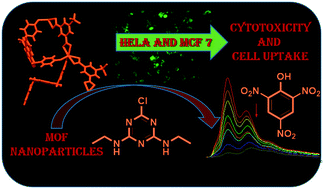
CrystEngComm, 2020,22, 4468-4477
https://doi.org/10.1039/D0CE00490A
A dye@MOF crystalline probe serving as a platform for ratiometric sensing of trichloroacetic acid (TCA), a carcinogen metabolite in human urine
Novel microporous dual-emitting dye@MOF FS@1 hybrid has been designed and prepared to effectively detect TCA, the biomarker for carcinogenic TCE in human urine.
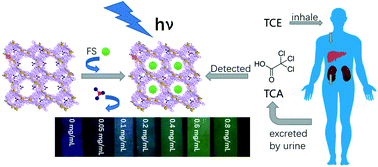
CrystEngComm, 2019,21, 4637-4643
https://doi.org/10.1039/C9CE00924H
Degradation of ZIF-8 in phosphate buffered saline media
Understanding the stability of zeolitic imidazolate framework-8 (ZIF-8) under physiological conditions is critical in biotechnology and biomedicine for biosensing, biocatalysis, and drug delivery.

CrystEngComm, 2019,21, 4538-4544
https://doi.org/10.1039/C9CE00757A
Controlled synthesis of Fe3O4@ZIF-8 nanoparticles for drug delivery
A novel one-pot synthetic method is introduced to produce Fe3O4@ZIF-8 NPs, which are proven to have potential applications as drug delivery models.
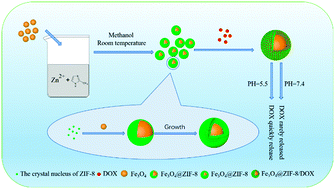
CrystEngComm, 2018,20, 7486-7491
https://doi.org/10.1039/C8CE01302K
Fluorogenic naked-eye sensing and live-cell imaging of cyanide by a hydrazine-functionalized CAU-10 metal–organic framework
A hydrazine-functionalized Al(III) based metal–organic framework was utilized for the detection of lethal cyanide in water and in living cells.
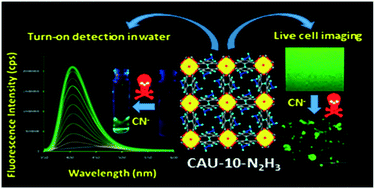
CrystEngComm, 2018,20, 4194-4201
https://doi.org/10.1039/C8CE00818C
Two structurally diverse Zn-based coordination polymers with excellent antibacterial activity
Two novel Zn-based coordination polymers with unique structural properties display an exceptional antibacterial activity against Gram-positive and Gram-negative bacteria.
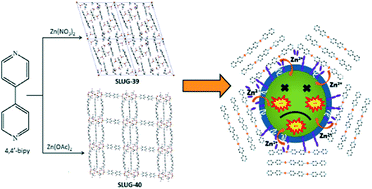
CrystEngComm, 2018,20, 3353-3362
https://doi.org/10.1039/C8CE00394G
A lanthanide functionalized MOF hybrid for ratiometric luminescence detection of an anthrax biomarker
A dual-emitting hybrid platform based on a lanthanide functionalized MOF was demonstrated as a fluorescent indicator for ratiometric detection of an anthrax biomarker—dipicolinic acid (DPA).
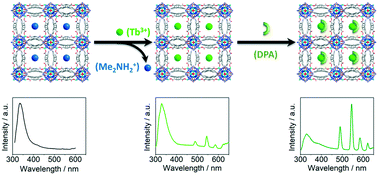
CrystEngComm, 2018,20, 1264-1270
https://doi.org/10.1039/C7CE01994G
One-pot synthesis of hierarchical-pore metal–organic frameworks for drug delivery and fluorescent imaging
A one-pot process has been developed for the synthesis of hierarchical-pore metal–organic frameworks, aimed at loading large and small drug molecules simultaneously.
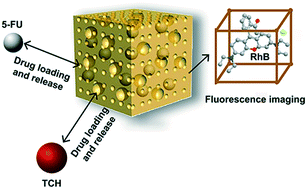
CrystEngComm, 2018,20, 1087-1093
https://doi.org/10.1039/C7CE02053H
About this collection
Metal-organic Frameworks (MOFs) first captured the interest of the scientific community due to their remarkable gas adsorption properties. Subsequently, the scope of MOF chemistry swiftly expanded as researchers continued to explore and uncover new applications for these versatile materials. This Editor’s collection, guest edited by Associate Editor Christian Doonan, highlights recent contributions to CrystEngComm that are broadly focussed on bio-applications of MOFs. The selection of articles showcases the wide range of topics where MOFs are being employed to address research challenges and questions in biological science including, cellular imaging, drug delivery and release, chemical sensing, and biocatalysis. While MOFs are the common link between these studies the core concepts of crystal engineering feature prominently and thus point towards the richness and diversity of this area of chemistry.